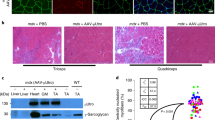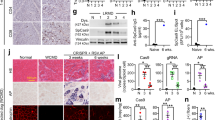Abstract
Intramuscular administration of plasmid expressing full- length human dystrophin in dystrophin-deficient adult mdx mice resulted in humoral and weak specific T cell responses against the human dystrophin protein. Following plasmid injection, human dystrophin was detected in the injected muscles at 7 days, but decreased thereafter. Anti-dystrophin antibodies were found 21 days following plasmid injection, which coincided with transient myositis. This immune rejection prevented the mice from expressing human dystrophin after a second plasmid injection. No anti-DNA antibodies were found. Anti-dystrophin antibodies were seen in a smaller proportion of plasmid-injected dystrophin-competent C57BL/10 mice, suggesting that the immune rejection of dystrophin may be explained partially by species differences in the dystrophin protein.
This is a preview of subscription content, access via your institution
Access options
Subscribe to this journal
Receive 12 print issues and online access
$259.00 per year
only $21.58 per issue
Buy this article
- Purchase on Springer Link
- Instant access to full article PDF
Prices may be subject to local taxes which are calculated during checkout






Similar content being viewed by others

References
Hoffman EP, Brown RH, Kunkel LM . Dystrophin: the protein product of the Duchenne muscular dystrophy locus Cell 1987 51: 919–928
Inui K, Okada S, Dickson G . Gene therapy in Duchenne muscular dystrophy Brain Dev 1996 18: 357–361
Fassati A, Murphy S, Dickson G . Gene therapy of Duchenne Muscular Dystrophy Adv Genet 1997 35: 117–153
Bulfield G, Siller WG, Wight PA, Moore KJ . X chromosome-linked muscular dystrophy (mdx) in the mouse Proc Natl Acad Sci USA 1984 81: 1189–1192
Sicinski P et al. The molecular basis of muscular dystrophy in the mdx mouse: a point mutation Science 1989 244: 1578–1580
England SB et al. Very mild muscular dystrophy associated with the deletion of 46% of dystrophin Nature 1990 343: 180–182
Lochmüller H et al. Transient immunosuppression by FK506 permits a sustained high-level dystrophin expression after adenovirus-mediated dystrophin minigene transfer to skeletal muscles of adult dystrophic (mdx) mice Gene Therapy 1996 3: 706–716
Acsadi G et al. Human dystrophin expression in mdx mice after intramuscular injection of DNA constructs Nature 1991 352: 815–818
Howell JM et al. High-level dystrophin expression after adenovirus-mediated dystrophin minigene transfer to skeletalmuscle of dystrophic dogs: prolongation of expression with immunosuppression Hum Gene Ther 1998 9: 629–634
Ohtsuka Y et al. Dystrophin acts as a transplantation rejection antigen in dystrophin-deficient mice: implication for gene therapy J Immunol 1998 160: 4635–4640
Mendell JR et al. Myoblast transfer in the treatment of Duchenne's muscular dystrophy New Engl J Med 1995 333: 832–838
Tremblay JP et al. Results of a triple blind clinical study of myoblast transplantations without immunosuppressive treatment in young boys with Duchenne muscular dystrophy Cell Transplant 1993 2: 99–112
Gussoni E, Blau HM, Kunkel LM . The fate of individualmyoblasts after transplantation into muscles of DMD patients Nature Med 1997 3: 970–977
Huard J et al. Human myoblast transplantation between immunohistocompatible donors and recipients produces immune reactions Transplant Proc 1992 24: 3049–3051
Miller RG et al. Myoblast implantation in Duchenne muscular dystrophy: the San Francisco study Muscle Nerve 1997 20: 469–478
Roy E et al. Antibody formation after myoblast transplantation in Duchenne-dystrophic patients, donor HLA compatible Transplant Proc 1993 25: 995–997
Karpati G et al. Myoblast transfer in Duchenne muscular dystrophy Ann Neurol 1993 34: 8–17
Huard J et al. Human myoblast transplantation: preliminary results of 4 cases Muscle Nerve 1992 15: 550–560
Tremblay JP et al. Myoblast transplantation between monozygotic twin girl carriers of Duchenne muscular dystrophy Neuromusc Disord 1993 3: 583–592
Law PK et al. First human myoblast transfer therapy continues to show dystrophin after 6 years Cell Transplant 1997 6: 95–100
Partridge T et al. Meeting of the Cell Transplantation Society in Miami (letter) Cell Transplant 1997 6: 195–198
Guérette B et al. Lymphocyte infiltration following allo- and xenomyoblast transplantation in mdx mice Muscle Nerve 1995 18: 39–51
Labrecque C, Roy R, Tremblay JP . Immune reactions after myoblast transplantation in mouse muscles Transplant Proc 1992 24: 2889–2892
Yang L et al. Adenovirus-mediated dystrophin minigene transfer improves muscle strength in adult dystrophic (mdx) mice Gene Therapy 1998 5: 369–379
Pagel CN, Morgan JE . Myoblast transfer and gene therapy in muscular dystrophies Microsc Res Tech 1995 30: 469–479
Wolff JA et al. Direct gene transfer into mouse muscle in vivo Science 1990 247: 1465–1468
Danko I et al. Dystrophin expression improves myofiber survival in mdx muscle following intramuscular plasmid DNA injection Hum Mol Genet 1993 2: 2055–2061
Wolff JA et al. Long-term persistence of plasmid DNA and foreign gene expression in mouse muscle Hum Mol Genet 1992 1: 363–369
Davis HL, Millan CL, Watkins SC . Immune-mediated destruction of transfected muscle fibers after direct gene transfer with antigen-expressing plasmid DNA Gene Therapy 1997 4: 181–188
Bittner RE et al. Coisogenic all-plus-one immunization: a model for identifying missing proteins in null-mutant conditions. Antibodies to dystrophin in mdx mouse after transplantation ofmuscle from normal coisogenic donor Neuropediatrics 1994 25: 176–182.
Vilquin JT et al. Successful histocompatible myoblast transplantation in dystrophin-deficient mdx mouse despite the production of antibodies against dystrophin J Cell Biol 1995 131: 975–988
Byers TJ, Neumann PE, Beggs AH, Kunkel LM . ELISA quantitation of dystrophin for the diagnosis of Duchenne and Becker muscular dystrophies Neurology 1992 42: 570–576
Morris GE, Ellis JM, Nguyen TM . A quantitative ELISA for dystrophin J Immunol Methods 1993 161: 23–28
Ishikawa Y, Ishikawa Y, Minami R . Quantitative estimation of dystrophin protein: a sensitive and convenient two-antibody sandwich ELISA Tohoku J Exp Med 1996 180: 57–63
Braun S et al. Gene transfer into canine myoblasts Cytotechnology 1999 30: 181–189
Harris JB, Johnson MA, Karlsson E . Pathological responses of rat skeletal muscle to a single subcutaneous injection of a toxin from the venom of the Australian tiger snake, Notechis scutatus scutatus Clin Exp Pharm Physiol 1975 2: 383–404
Huard J et al. Utilization of an antibody specific for human dystrophin to follow myoblast transplantation in nude mice Cell Transplant 1993 2: 113–118
Hoffman EP et al. Somatic reversion/suppression of the mdx phenotype in vivo J Neurol Sci 1990 99: 9–25
Miller G et al. Expression of factor VII by muscle cells in vitro and in vivo following direct gene transfer: modelling gene therapy for haemophilia Gene Therapy 1995 2: 736–742
Mor G et al. Do DNA vaccines induce autoimmune disease? Hum Gene Ther 1997 8: 293–300
Hahn BH . Antibodies to DNA New Engl J Med 1998 338: 1359–1368
Acsadi G et al. Dystrophin expression in muscles of mdx mice after adenovirus-mediated in vivo gene transfer Hum Gene Ther 1996 7: 129–140
Michou AI et al. Adenovirus-mediated gene transfer: influence of transgene, mouse strain and type of immune response on persistence of transgene expression Gene Therapy 1997 4: 473–482
Wells KE et al. Immune responses, not promoter inactivation, are responsible for decreased long-term expression following plasmid gene transfer into skeletal muscle FEBS Lett 1997 407: 164–168
Levy MY, Barron LG, Meyer KB, Szoka FC . Characterization of plasmid DNA transfer into mouse skeletal muscle: evaluation of uptake mechanism, expression and secretion of gene products into blood Gene Therapy 1996 3: 201–211
Fanin M et al. Dystrophin-positive fibers in Duchenne dystrophy: origin and correlation to clinical course Muscle Nerve 1995 18: 1115–1120
Danko I, Chapman V, Wolff JA . The frequency of revertants in mdx mouse genetic models for Duchenne muscular dystrophy Pediatr Res 1992 32: 128–131
Bittner RE et al. Serum antibodies to the delivered dystrophin sequence after cardiac transplantation in a patient with Becker's muscular dystrophy New Engl J Med 1995 333: 732–733
Amalfitano A, Rafael JA, Chamberlain JS . Structure and mutation of the dystrophin gene. In: Brown SC, Lucy JA (eds) Dystrophin: Gene, Protein and Cell Biology Cambridge University Press: Cambridge, UK 1997 pp 1–26
Donnelly JJ, Ulmer JB, Liu MA . DNA vaccines Life Sci 1997 60: 163–172
MacGregor RR et al. First human trial of a DNA-based vaccine for treatment of human immunodeficiency virus type 1 infection: safety and host response J Infect Dis 1998 178: 92–100
Wang R et al. Induction of antigen-specific cytotoxic T lymphocytes in human by a malaria DNA vaccine Science 1998 282: 476–480
Corr M, Lee DJ, Carson DA, Tighe H . Gene vaccination with naked plasmid DNA: mechanism of CTL priming J Exp Med 1996 184: 1555–1560
Nicholson LVB et al. Heterogeneity of dystrophin expression in patients with Duchenne and Becker muscular dystrophy Acta Neuropathol 1990 80: 239–250
Tinsley J et al. Expression of full-length utrophin prevents muscular dystrophy in mdx mice Nature Med 1998 4: 1441–1444
Budker V et al. The efficient expression of intravascularly delivered DNA in rat muscle Gene Therapy 1998 5: 272–276
Gautier C, Mehtali M, Lathe R . A ubiquitous mammalian expression vector, pHMG, based on a housekeeping gene promoter Nucleic Acids Res 1989 17: 8389
Sambrook J, Fritsch EF, Maniatis T . Molecular Cloning – A Laboratory Manual, 2nd edn Cold Spring Harbor Laboratory Press: Cold Spring Harbor, NY 1989
Bordier C . Phase separation of integral membrane proteins in Triton X-114 solution J Biol Chem 1981 256: 1604–1607
Manthorpe M et al. Gene therapy by intramuscular injection of plasmid DNA: studies on firefly luciferase gene expression in mice Hum Gene Ther 1993 4: 419–431
Ragot T et al. Efficient adenovirus-mediated transfer of a human minidystrophin gene to skeletal muscle of mdx mice Nature 1993 361: 647–650
Askanas V, Engel WK . Cultured normal and genetically abnormal human muscle. In: LP Rowland, S DiMauro (eds) Handbook of Clinical Neurology: Myopathies Elsevier Science Publishers: Amsterdam 1992 18: 85–116
Graham F, Van der Eb A . A new technique for the assay of infection of human adenovirus 5 DNA Virology 1973 52: 456–467
Pande SV, Murthy MSR . A modified micro-Bradford procedure for elimination of interference from sodium dodecyl sulfate, other detergents, and lipids Anal Biochem 1994 220: 424–426
Mayr A et al. Der Pockenimpfstamm MVA: Larker, genetische Struktur, erfahrungen mit der parenteralen Schutzimpfung und Verhalten im abswehrgeschwächten Organismus Zbl Bakt Hyg, I Abt Orig B 1978 167: 375–390
Mahnel H, Mayr A . Experiences with immunization against orthopox viruses of humans and animals using vaccine strain MVA Berl Munch Tierarztl Wochenschr 1994 107: 253–256
Lusky M, Botchan M . Inhibition of SV40 replication in simian cells by specific pBR322 DNA sequences Nature 1981 293: 79–81
Falkner FG, Moss B . Escherichia coli gpt gene provides dominant selection for vaccinia virus open reading frame expression vectors J Virol 1988 62: 1849–1854
Dickson G et al. Human dystrophin gene transfer: production and expression of a recombinant cDNA-based gene Hum Genet 1991 88: 53–58
Acknowledgements
We are especially grateful to Professor George Dickson for his contribution to our research project. The authors thank Isabelle Renardet for providing purified plasmid DNA; Klaus Schughart, Head of Transgène's animal facility; Fabrice Augé, Grégory Amann, and David Bock for animal care; Virginie Nourtier, Gwenaelle Legoc, Doris Schmitt, and Karine Dott for technical assistance; and Dominic Wells for helpful discussions. This work was supported by the Association Française contre les Myopathies (AFM).
Author information
Authors and Affiliations
Rights and permissions
About this article
Cite this article
Braun, S., Thioudellet, C., Rodriguez, P. et al. Immune rejection of human dystrophin following intramuscular injections of naked DNA in mdx mice. Gene Ther 7, 1447–1457 (2000). https://doi.org/10.1038/sj.gt.3301261
Received:
Accepted:
Published:
Issue Date:
DOI: https://doi.org/10.1038/sj.gt.3301261
Keywords
This article is cited by
-
In Vivo Genome Engineering for the Treatment of Muscular Dystrophies
Current Stem Cell Reports (2020)
-
Ex-vivo Analysis of the Bone Microenvironment in Bone Metastatic Breast Cancer
Journal of Mammary Gland Biology and Neoplasia (2009)
-
Long-term expression of full-length human dystrophin in transgenic mdx mice expressing internally deleted human dystrophins
Gene Therapy (2004)


